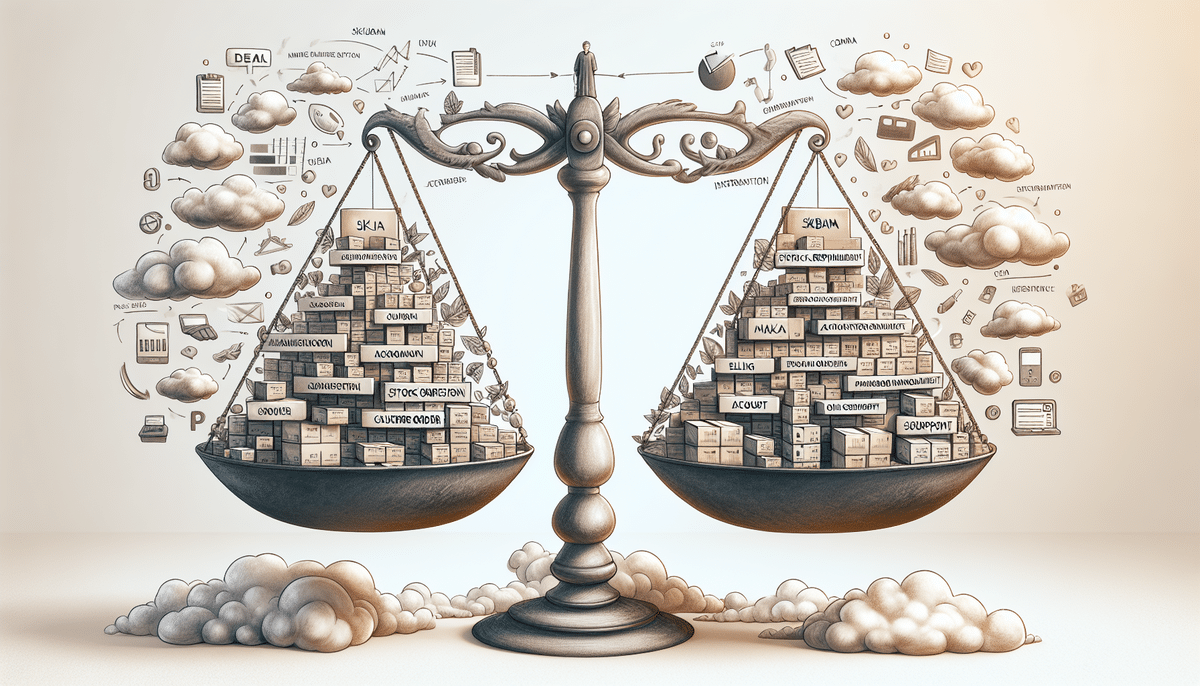Skubana vs DEAR Inventory: Comprehensive E-commerce Management Software Comparison
Managing inventory in the bustling world of e-commerce can be challenging. With a multitude of products to track, orders to fulfill, and suppliers to manage, businesses often seek robust solutions to streamline their operations. Skubana and DEAR Inventory are two leading e-commerce management software options designed to address these complexities. This article delves into their key features, integration capabilities, ease of use, pricing, customer support, user feedback, and provides a final verdict to help you determine which solution best fits your business needs.
Introduction to Skubana and DEAR Inventory
Skubana and DEAR Inventory are cloud-based platforms tailored to optimize e-commerce operations. They focus on inventory management, order processing, supplier coordination, and offer comprehensive reporting tools to enhance business profitability and efficiency.
Both platforms are highly customizable, allowing businesses to tailor functionalities to their specific requirements. They seamlessly integrate with major e-commerce platforms such as Shopify, Amazon, eBay, WooCommerce, and Magento, enabling centralized management of all sales channels. Additionally, both offer extensive customer support and resources to maximize the utility of their software.
Key Features and Benefits
Skubana Features
- Multi-Channel Selling: Manage sales across various platforms like Amazon, eBay, and your own website from a single dashboard.
- Automated Stock Replenishment: Automatically reorder inventory based on predefined thresholds to prevent stockouts.
- Advanced Analytics and Reporting: Gain insights into sales performance, inventory turnover, and operational efficiency.
- Integrated Shipping and Fulfillment: Streamline the shipping process by integrating with major carriers and managing fulfillment centrally.
DEAR Inventory Features
- Inventory Management: Comprehensive tracking of stock levels, locations, and movements.
- Purchase and Sales Orders: Efficiently manage purchase orders from suppliers and sales orders to customers.
- Bill of Materials (BOM) Management: Track the cost of products down to individual components, aiding in pricing strategies.
- Financial Management: Integration with accounting systems like QuickBooks and Xero for seamless financial tracking.
Common Benefits
- Operational Optimization: Automate routine tasks such as order processing and inventory tracking to focus on strategic growth.
- Cost Reduction: Minimize errors and reduce operational costs through streamlined processes.
- Enhanced Customer Service: Real-time inventory updates and customizable communication templates improve customer satisfaction.
Integration Capabilities
Both Skubana and DEAR Inventory offer robust integration options, allowing businesses to connect with various third-party applications seamlessly.
Skubana Integrations
- Marketplaces: Amazon, eBay
- Shipping Carriers: UPS, FedEx
- Accounting Software: QuickBooks, Xero
- Email Marketing: Mailchimp, Klaviyo
DEAR Inventory Integrations
- E-commerce Platforms: Shopify, WooCommerce, Magento
- Shipping Carriers: FedEx, UPS
- CRM Systems: Salesforce
- Accounting Software: Xero, QuickBooks
These integrations facilitate automated data transfer between systems, reducing manual entry and minimizing errors. Additionally, both platforms support integration with emerging technologies to enhance operational capabilities.
Ease of Use
User experience is a critical factor in selecting e-commerce management software. Both Skubana and DEAR Inventory offer intuitive interfaces, but they cater to different user preferences.
Skubana Usability
Skubana features a visually appealing dashboard that provides a real-time overview of all operations. Its drag-and-drop functionality allows users to organize and manipulate data effortlessly, making it accessible for users with varying technical expertise.
DEAR Inventory Usability
DEAR Inventory offers a more complex interface with advanced customization options for reports and workflows. While it may require a steeper learning curve, it provides powerful tools for businesses that need detailed customization and in-depth data analysis.
Both platforms provide comprehensive onboarding and customer support to ensure a smooth implementation process.
Pricing Plans and Packages
Understanding the pricing structure is essential in choosing the right software for your business. Here's a breakdown of the pricing plans for both Skubana and DEAR Inventory.
Skubana Pricing
- Essentials: $999 per month
- Professional: $1,999 per month
The Essentials plan includes core features like inventory management, order processing, and shipping integration. The Professional plan adds advanced analytics, custom reporting, and dedicated support.
DEAR Inventory Pricing
- Tier 1: $199 per month
- Tier 2: $499 per month
- Tier 3: $1,299 per month
DEAR Inventory's Tier 1 covers basic inventory and sales management, Tier 2 introduces manufacturing and job costing, and Tier 3 offers advanced features like serial tracking and multi-warehouse management.
Both platforms offer free trials, allowing businesses to evaluate their features before committing. Customized pricing is also available for enterprises with specific needs.
Customer Support
Reliable customer support can significantly impact your experience with e-commerce management software. Here's how Skubana and DEAR Inventory compare:
Skubana Support
- Channels: Phone, Email
- Resources: Extensive knowledge base, detailed tutorials, online forums
- Reputation: Known for prompt and personalized support with expert assistance available.
DEAR Inventory Support
- Channels: Phone, Online Chat
- Resources: Comprehensive documentation, limited tutorials
- Reputation: Some users report slower response times and less personalized support compared to Skubana.
Choosing a platform with responsive and helpful support ensures that any issues can be swiftly addressed, minimizing downtime and maintaining operational efficiency.
User Reviews and Testimonials
Feedback from actual users provides valuable insights into the strengths and weaknesses of each platform.
Skubana User Feedback
Users praise Skubana for its intuitive interface, powerful analytics, and seamless multi-channel integration. However, some mention that its pricing may be prohibitive for small businesses.
DEAR Inventory User Feedback
DEAR Inventory is lauded for its comprehensive inventory management and BOM tracking. On the downside, some users highlight limited integrations and slower customer support response times.
Overall, both platforms receive positive reviews for their ability to enhance e-commerce operations, with specific strengths catering to different business needs.
Pros and Cons
Evaluating the advantages and disadvantages of each platform can guide you in making an informed decision.
Pros of Skubana
- Multi-channel selling capabilities
- Integrated shipping and fulfillment
- Advanced analytics and reporting
Cons of Skubana
- Higher pricing plans may not be suitable for smaller businesses
Pros of DEAR Inventory
- Comprehensive BOM management
- Customizable reporting options
- Robust cost tracking and financial management
Cons of DEAR Inventory
- Limited third-party integrations
- Slower customer support response times
Consider these factors in relation to your business requirements to choose the most suitable platform.
Final Verdict: Skubana or DEAR Inventory?
The choice between Skubana and DEAR Inventory hinges on your business's specific needs and priorities.
Skubana excels in multi-channel management and integrated shipping, making it ideal for businesses aiming to expand their sales channels and enhance fulfillment efficiency. Its advanced analytics provide valuable insights for strategic decision-making.
DEAR Inventory stands out with its detailed BOM management and customizable reporting, catering to businesses that require meticulous cost tracking and inventory control. Its comprehensive financial integrations support accurate financial management.
Ultimately, evaluate your operational needs, budget constraints, and long-term business goals to determine which platform aligns best with your objectives.
Tips for Choosing the Right E-commerce Management Software
Selecting the appropriate e-commerce management software is crucial for operational success. Here are key factors to consider:
- Integration Capabilities: Ensure the software seamlessly integrates with your existing tools and platforms.
- Ease of Use: A user-friendly interface can reduce the learning curve and boost productivity.
- Pricing Plans: Choose a plan that fits your budget while offering essential features.
- Customer Support: Reliable and responsive support can help resolve issues promptly.
- Feature Set: Look for features that optimize operations and drive profitability, such as inventory management, order fulfillment, and comprehensive reporting.
Assess your business’s unique needs and prioritize features that will facilitate growth and efficiency.
How to Migrate Between E-commerce Management Software
Transitioning from one e-commerce management software to another requires careful planning to ensure continuity in operations. Follow these steps for a smooth migration:
- Assess Current Processes: Evaluate your existing workflows and identify data and processes that need to be transferred.
- Select the New Software: Choose a platform that better aligns with your current and future needs.
- Data Mapping: Ensure all data fields in the current system correspond accurately to those in the new system to prevent inconsistencies.
- Pilot Testing: Implement the new software in parallel with the old system to identify and address any issues before full-scale migration.
- Team Training: Provide comprehensive training to ensure your team is proficient with the new software functionalities.
Effective migration minimizes disruptions and ensures that your business operations continue seamlessly.
The Future of E-commerce Management Software: Emerging Trends
The landscape of e-commerce management software is rapidly evolving, influenced by technological advancements and changing market demands. Key trends to watch include:
- Artificial Intelligence and Machine Learning: Enhancing predictive analytics, personalizing customer experiences, and automating complex tasks.
- Mobile Commerce: Increasing focus on mobile-first interfaces and functionalities as mobile shopping continues to grow.
- Advanced Data Analytics and Reporting: Providing deeper insights into customer behavior, inventory trends, and sales performance.
- Integration with Emerging Technologies: Incorporating blockchain for supply chain transparency and IoT for real-time inventory tracking.
- Enhanced Automation: Further automating routine tasks to allow businesses to concentrate on strategic initiatives.
Staying abreast of these trends can help businesses adopt forward-thinking software solutions that are adaptable to the dynamic e-commerce environment.
Case Studies: Success Stories with Skubana and DEAR Inventory
Exploring real-world applications of Skubana and DEAR Inventory showcases their effectiveness in diverse business contexts:
- Minaal: An outdoor travel gear company that leverages Skubana to manage multi-channel sales, optimize inventory levels, and streamline order fulfillment.
- Haus: A direct-to-consumer spirits company that utilizes Skubana for integrated shipping and advanced analytics to scale operations efficiently.
- Boppy: A baby products company using DEAR Inventory to manage complex inventory needs, track costs, and maintain accurate financial records.
- Masi Bikes: A premium bike manufacturer employing DEAR Inventory for comprehensive BOM management and multi-warehouse operations.
These case studies highlight the versatility and scalability of both platforms, demonstrating their capability to support business growth across various industries.
Conclusion
Choosing between Skubana and DEAR Inventory depends on your specific business requirements. Both platforms offer robust features to enhance e-commerce operations, but their unique strengths cater to different business needs. Evaluate your operational priorities, budget, and long-term goals to select the software that best aligns with your business strategy.




















